Australian megafauna
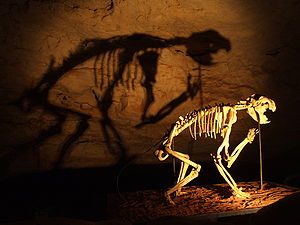
Australian megafauna comprises a number of large animal species in Australia, often defined as species with body mass estimates of greater than 45 kilograms[1] or equal to or greater than 130% of the body mass of their closest living relatives. Many of these species became extinct during the Pleistocene (16,100±100 – 50,000 years BC).[2]
There are similarities between prehistoric Australian megafauna and some mythical creatures from the Aboriginal dreamtime (Mackness 2009).[citation needed]
Causes of extinction
The cause of the extinction is an active, contentious and factionalised field of research where politics and ideology often takes precedence over scientific evidence.[3] It is hypothesised that with the arrival of early Australian Aboriginals (around 48,000–60,000 years ago), hunting and the use of fire to manage their environment may have contributed to the extinction of the megafauna.[4] Increased aridity during peak glaciation (about 18,000 years ago) may have also contributed.
New evidence based on accurate optically stimulated luminescence and uranium-thorium dating of megafaunal remains suggests that humans were the ultimate cause of the extinction of megafauna in Australia.[5][6] The dates derived show that all forms of megafauna on the Australian mainland became extinct in the same rapid timeframe — approximately 46,000 years ago[1] — the period when the earliest humans first arrived in Australia. Analysis of oxygen and carbon isotopes from teeth of megafauna indicate the regional climates at the time of extinction were similar to arid regional climates of today and that the megafauna were well adapted to arid climates.[5] The dates derived have been interpreted as suggesting that the main mechanism for extinction was human burning of a landscape that was then much less fire-adapted; oxygen and carbon isotopes of teeth indicate sudden, drastic, non-climate-related changes in vegetation and in the diet of surviving marsupial species. However, early Australian Aborigines appear to have rapidly eliminated the megafauna of Tasmania about 41,000 years ago (following formation of a land bridge to Australia about 43,000 years ago as ice age sea levels declined) without using fire to modify the environment there,[7][8][9] implying that at least in this case hunting was the most important factor. It has also been suggested that the vegetational changes that occurred on the mainland were a consequence, rather than a cause, of the elimination of the megafauna.[7] This idea is supported by sediment cores from Lynch's Crater in Queensland, which indicate that fire increased in the local ecosystem about a century after the disappearance of megafaunal browsers, leading to a subsequent transition to fire-tolerant sclerophyll vegetation.[10][11][12]
Chemical analysis of fragments of eggshells of Genyornis newtoni, a flightless bird that became extinct in Australia, from over 200 sites, revealed scorch marks consistent with cooking in human-made fires, presumably the first direct evidence of human contribution to the extinction of a species of the Australian megafauna.[13]
Living Australian megafauna
The term "megafauna" is usually applied to large animals (over 100 kg). In Australia, however, megafauna were never as large as those found on other continents, and so a more lenient criterion of over 40 kg is often applied[14]
Mammals
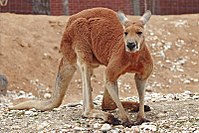
- The red kangaroo (Macropus rufus) is a very large kangaroo with short, red-brown fur, fading to pale buff near the limbs. It has long, pointed earlobes and a squared-off muzzle. Females are smaller than males and are blue-grey with a brown tinge, although females from arid zones are coloured more like males. The red kangaroo has two forelimbs with small claws, two muscular legs for jumping, and a tail often used as a third leg (for balance).
- The red kangaroo's legs work much like a rubber band. The male can leap approximately 9.4 m in one leap. He grows up to 1.8 m tall and weighs up to 85 kg (187 lb). Females grow up to 1.1 m tall and weigh up to 35 kg (77 lb). Tails on both males and females can be up to 1 m long.[citation needed]
- Eastern grey kangaroos (Macropus giganteus) are marsupials found in southern and eastern Australia, with a population of several million. Although a male typically weighs around 66 kg (145 lb) and stand almost 2 m tall, the scientific name Macropus giganteus (gigantic large-foot) is misleading, as the red kangaroo living in the semi-arid inland is larger.
- The antilopine kangaroo (Macropus antilopinus), sometimes called the antilopine wallaroo or the antilopine wallaby, is a species of macropod found in northern Australia at Cape York Peninsula in Queensland, the Top End of the Northern Territory, and the Kimberley region of Western Australia. It is common locally, and a gregarious grazer.[15]
- Eastern wallaroos (Macropus robustus), also called hill wallaroos, are generally found in a variety of habitats, such as forests, deserts, and grasslands. They can weigh as much as 15–47 kg(103 lb) and grow over a metre long.
- Common wombats (Vombatus ursinus) can reach 25–40 kg(55 lb). They thrive in Eastern Australia and Tasmania, preferring temperate forests and highland regions.
- The southern hairy-nosed wombat (Lasiorhinus latifrons) only weighs 19–32 kg(41 lb). Compared to the common wombat, the southern hairy-nosed wombat is stockier and has shorter limbs.
Birds
This article has an unclear citation style. (February 2012) |

- The emu (Dromaius novaehollandiae) was first described under the name "New Holland cassowary" in Arthur Phillip's Voyage to Botany Bay, published in 1789.[4] Dromaius novaehollandiae is Latin for "fast-footed New Hollander". The species was named by ornithologist John Latham, who collaborated with Phillip on his book and provided the first descriptions of and names for many Australian bird species. The etymology of the common name "emu" is uncertain, but is thought to have come from an Arabic word for a large bird that was later used by Portuguese explorers to describe related cassowaries in New Guinea.[5] In Victoria, some terms for the emu included "barrimal" in the Djadja wurrung language, "myoure" in Gunai, and "courn" in Jardwadjali.[6]
- The original describer of the emu Vieillot used two generic names: first Dromiceius, then Dromaius a few pages later. Ever since, there has been debate over which is correct, [7] but most modern publications, including those of the Australian government,[8] use Dromaius.
- The northern and dwarf cassowaries are not well known. Cassowaries are usually shy, secretive birds of the deep forest, adept at disappearing long before a human knows they are there. Even the more accessible southern cassowary of the Queensland rain forests is not well understood.
Reptiles
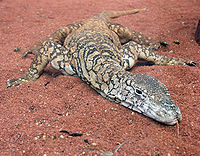
- Goanna, being predatory lizards, are often quite large or bulky, with sharp teeth and claws. The largest goanna is the perentie (Varanus giganteus), which can grow over 2 m in length. Not all goannas are gargantuan though: pygmy goannas may be smaller than a man's arm. The smallest of these, the short-tailed monitor (Varanus brevicauda) reaches only 20 cm in length. They survive on smaller prey such as insects and mice. However, most goannas prey on all manner of small animals: insects, lizards, snakes, mammals, and birds. Goannas are also eaters of carrion and are attracted to rotting meat. Meals are often eaten whole, though the a perentie has been observed killing a young kangaroo, and then biting out chunks of flesh. Goannas have even been blamed for the death of sheep by farmers, though most likely erroneously.
- A healthy adult male saltwater crocodile (Crocodylus porosus) is typically 4.8–7 m long and weighs around 770 kg(1,694 lb), with many being much larger than this.[2] The female is much smaller, with typical body lengths of 2.5–3 m. An 8.5 m saltwater crocodile was reportedly shot on the Norman River of Queensland in 1957; a cast was made of it and is on display as a popular tourist attraction. However, due to the lack of solid evidence (other than the plaster) and the length of time since the crocodile was caught, it is not considered "official".[clarification needed] The saltwater crocodile has fewer armour plates on its neck than other crocodilians. Its body is broader as well, leading to early assumption that it was an alligator. The saltwater crocodile is the largest extant animal native to Australia that spends any portion of its time on land.
- Freshwater crocodile (Crocodylus johnsoni) The freshwater crocodile is a relatively small crocodilian. Males can grow to 2.3–3 m (7.5–9.8 ft) long, while females reach a maximum size of 2.1 m (6.9 ft).Males commonly weigh around 40 kg (88 lb), with large specimens up to 53 kg (120 lb) or more, against the female weight of 20 kg (44 lb). In areas such as Lake Argyle and Katherine Gorge there exist a handful of confirmed 4 metres (13 ft) individuals.
Extinct Australian megafauna
The following is an incomplete list of extinct Australian megafauna (monotremes, marsupials, birds and reptiles) in the format:
- Latin name, (common name, period alive), and a brief description.
Monotremes
Monotremes are arranged by size with the largest at the top.
- Zaglossus hacketti was a sheep-sized echidna uncovered in Mammoth Cave in Western Australia, and is the largest monotreme so far uncovered.
- Obdurodon dicksoni was a platypus up to 60 cm in total length, fossils of which were found at Riversleigh.
- Megalibgwilia ramsayi was a large, long-beaked echidna with powerful forelimbs for digging. Its diet would probably have included worms and grubs rather than ants.
Marsupials
Marsupials are arranged by size, with the largest at the top.
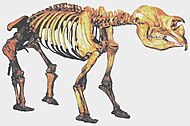
1,000–2,000 kilograms[16]
- Diprotodon optatum was the largest species of diprotodontid. Approximately three metres long, two metres high at the shoulder and weighing up to 2,780 kg, it resembled a giant wombat. It is the largest marsupial currently known.
- Zygomaturus trilobus was a smaller (bullock-sized, about two metres long by one metre high) diprotodontid that may have had a short trunk. It appears to have lived in wetlands, using two fork-like incisors to shovel up reeds and sedges for food.
- Palorchestes azael (the marsupial tapir) was a diprotodontoid similar in size to Zygomaturus. It had long claws and a longish trunk. It lived during the Pleistocene (Mackness 2009).
100–1,000 kilograms
- Euowenia grata
- Euryzygoma dunense
- Phascolonus gigas
- Ramsayia magna
- Procoptodon goliah (giant short-faced kangaroo) is the largest kangaroo to have ever lived. It grew 2–3 metres (7–10 feet) tall, and weighed up to 230 kilograms. It had a flat shortened face with jaw and teeth adapted for chewing tough semi-arid vegetation, and forward-looking eyes providing stereoscopic vision. Procoptodon was one of seventeen species in three genera in the sthenurine subfamily, all of which are extinct. Sthenurines inhabited open woodlands in central Northern Australia as the tropical rainforests were beginning to retreat. All sthenurines had an extremely developed, almost hoof-like, fourth toe on the hindlimbs, with other toes vestigial. Additionally, elastic ligaments between the toe bones gave this group improved spring and speed compared to modern kangaroos. Sthenurine forelimbs were long with two extra-long fingers and claws compared with the relatively small, stiff arms of modern macropods. These may have been used for pulling branches nearer for eating and for quadrupedal movement for short distances.
- Procoptodon rapha, P. pusio and P. texasensis
- Protemnodon a form of giant wallaby with 4 species.[17]
- Palorchestes parvus
- Macropus pearsoni and M. ferragus
- Thylacoleo carnifex (marsupial lion) was the largest meat eating mammal to have ever lived in prehistoric Australia, and was of comparable size to female placental-mammal lions and tigers
10–100 kilograms
- Simosthenurus pales
- Sthenurus tindalei and S. atlas
- Phascolarctos stirtoni was a koala similar to the modern form, but one third larger.
- Phascolomys medius
- Lasiorhinus angustidens
- Thylacine (Tasmanian tiger)
- Congruus congruus a wallaby from Naracoorte.
- Troposodon minor
- Sthenurus oreas
- Simosthenurus occidentalis (another sthenurine) was about as tall as a modern eastern grey kangaroo, but much more robust. It is one of the nine species of leaf-eating kangaroos identified in fossils found in the Naracoorte Caves National Park.
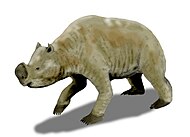
Zygomaturus trilobus - Simothenurus brownei
- Propleopus oscillans (the carnivorous kangaroo), from the Miocene and Pliocene epochs, was a large (~70 kilogram) rat-kangaroo with large shearing and stout grinding teeth that indicate it may have been an opportunistic carnivore able to eat insects, vertebrates (possibly carrion), fruits, and soft leaves. Grew to about 1.5 – 3 metres in height.
- Simothenurus maddocki
- Sthenurus andersoni
- Thylacoleo carnifex, (the marsupial lion), was the size of a leopard, and had a cat-like skull with large slicing pre-molars. It had a retractable thumb-claw and massive forelimbs. It was almost certainly carnivorous and a tree-dweller.
- Vombatus hacketti
- Macropus thor
- Macropus piltonensis
- Macropus rama
- Simothenurus gilli
- Warrendja wakefieldi a wombat from Naracoorte.
- Sarcophilus harrisii laniarius was a large form of the Tasmanian devil.
Birds
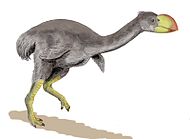
- Family Dromornithidae: this group of birds was more closely related to fowl than modern ratites.
- Dromornis stirtoni, (Stirton's thunder bird, Miocene epoch) was a flightless bird three metres tall that weighed about 500 kilograms. It is one of the largest birds so far discovered. It inhabited subtropical open woodlands and may have been carnivorous. It was heavier than the moa and taller than Aepyornis.
- Bullockornis planei (the 'demon duck of doom') was another huge member of the Dromornithidae. It was up to 2.5 metres tall and weighed up to 250 kilograms; it was probably carnivorous.
- Genyornis newtoni (the mihirung) was related to Dromornis, and was about the height of an ostrich. It was the last survivor of the Dromornithidae. It had a large lower jaw and was probably omnivorous.
- Leipoa gallinacea (formerly Progura) was a giant malleefowl.
Reptiles

- Varanus priscus (formerly Megalania prisca) was a giant, carnivorous goanna that might have grown to as long as 7 metres (23 feet), and weighed up to 1,940 kilograms (Molnar, 2004). Giant goannas and humans overlapped in time in Pleistocene Australia, but there is no evidence that they directly encountered each other.[18]
- Wonambi naracoortensis was a non-venomous snake of five to six metres in length. It was an ambush predator living at waterholes located in natural sun traps and killed its prey by constriction.
- Quinkana sp., was a terrestrial crocodile that grew from five to possibly 7 metres in length. It had long legs positioned underneath its body, and chased down mammals, birds and other reptiles for food. Its teeth were blade-like for cutting rather than pointed for gripping as with water dwelling crocodiles. It belonged to the mekosuchine subfamily (all now extinct). It was discovered at Bluff Downs in Queensland.
- L. dubudingala, lived during the Pliocene epoch, grew up to ten metres long, and is the largest Australian snake known. It hunted mammals, birds and reptiles in riparian woodlands. It is most similar to the extant olive python (Liasis olivacea).[19]
- Meiolania was a genus of huge terrestrial cryptodire turtle measuring 2.5 m (8 ft 4 inches) in length, with a horned head and spiked tail.
See also
Notes
- ^ a b Roberts, R. G.; Flannery, T. F.; Ayliffe, L. K.; Yoshida, H.; Olley, J. M.; Prideaux, G. J.; Laslett, G. M.; Baynes, A.; Smith, M. A.; Jones, R.; Smith, B. L. (2001-06-08). "New Ages for the Last Australian Megafauna: Continent-Wide Extinction About 46,000 Years Ago" (PDF). Science. 292 (5523): 1888–1892. doi:10.1126/science.1060264. PMID 11397939. Retrieved 2011-08-26.
- ^ a b Vanderwal and Fullager 1989 as cited in Josephine Flood (2004) Archaeology of the Dreamtime, J.B Publishing, Marleston p, 182 ISBN 1-876622-50-4
- ^ Claudio Tuniz, Richard Gillespie, Cheryl Jones The Bone Readers: Atoms, Genes and the Politics of Australia's Deep Past Allen & Unwin 2009 ISBN 9781741147285 Pg 14
- ^ Miller, G. H. (2005). "Ecosystem Collapse in Pleistocene Australia and a Human Role in Megafaunal Extinction". Science. 309: 287–290. doi:10.1126/science.1111288. PMID 16002615.
- ^ a b Prideaux, G. J.; Long, J. A.; Ayliffe, L. K.; Hellstrom, J. C.; Pillans, B.; Boles, W. E.; Hutchinson, M. N.; Roberts, R. G.; Cupper, M. L.; Arnold, L. J.; Devine, P. D.; Warburton, N. M. (2007-01-25). "An arid-adapted middle Pleistocene vertebrate fauna from south-central Australia". Nature. 445 (7126): 422–425. doi:10.1038/nature05471. PMID 17251978. Retrieved 2011-08-26.
- ^ Saltré, Frédérik; Rodríguez-Rey, Marta; Brook, Barry W.; Johnson, Christopher N; Turney, Chris S. M.; Alroy, John; Cooper, Alan; Beeton, Nicholas; Bird, Michael I.; Fordham, Damien A.; Gillespie, Richard; Herrando-Pérez, Salvador; Jacobs, Zenobia; Miller, Gifford H.; Nogués-Bravo, David; Prideaux, Gavin J.; Roberts, Richard G.; Bradshaw, Corey J. A. (2016). "Climate change not to blame for late Quaternary megafauna extinctions in Australia". Nature Communications. 7: 10511. doi:10.1038/ncomms10511. ISSN 2041-1723.
- ^ a b Diamond, Jared (2008-08-13). "Palaeontology: The last giant kangaroo". Nature. 454 (7206): 835–836. doi:10.1038/454835a. PMID 18704074. Retrieved 2011-05-08.
- ^ Turney, C. S. M.; Flannery, T. F.; Roberts, R. G.; et al. (2008-08-21). "Late-surviving megafauna in Tasmania, Australia, implicate human involvement in their extinction". Proceedings of the National Academy of Sciences of the United States of America. 105 (34). NAS: 12150–12153. doi:10.1073/pnas.0801360105. PMC 2527880. PMID 18719103. Retrieved 2011-05-08.
- ^ Roberts, R.; Jacobs, Z. (October 2008). "The Lost Giants of Tasmania" (PDF). Australasian Science. 29 (9): 14–17. Retrieved 2011-08-26.
- ^ Biello, D. (2012-03-22). "Big Kill, Not Big Chill, Finished Off Giant Kangaroos". Scientific American. Retrieved 2012-03-25.
- ^ McGlone, M. (2012-03-23). "The Hunters Did It". Science. 335 (6075): 1452–1453. doi:10.1126/science.1220176. Retrieved 2012-03-25.
- ^ Rule, S.; Brook, B. W.; Haberle, S. G.; Turney, C. S. M.; Kershaw, A. P. (2012-03-23). "The Aftermath of Megafaunal Extinction: Ecosystem Transformation in Pleistocene Australia". Science. 335 (6075): 1483–1486. doi:10.1126/science.1214261. Retrieved 2012-03-25.
- ^ "Human predation contributed to the extinction of the Australian megafaunal bird Genyornis newtoni ~ 47 ka". Nature Communication. 7 (10496). Nature Publishing Group. 29 January 2016. doi:10.1038/ncomms10496. Retrieved 1 February 2016.
{{cite journal}}: Cite uses deprecated parameter|authors=(help) - ^ Danielle Clode (2009) Prehistoric giants: the megafauna of Australia, Museum Victoria ISBN 978-0-9803813-2-0
- ^ Menkhorst, Peter (2001). A Field Guide to the Mammals of Australia. Oxford University Press. p. 110.
- ^ Flannery. T Pleistocene extinctions as cited in Josephine Flood (2004) Archaeology of the Dreamtime, J.B Publishing, Marleston p. 178 ISBN 1-876622-50-4
- ^ Helgen, K.M.; Wells, R.T.; Kear, B.P.; Gerdtz, W.R.; Flannery, T.F. (2006). "Ecological and evolutionary significance of sizes of giant extinct kangaroos". Australian Journal of Zoology. 54: 293–303. doi:10.1071/ZO05077.
- ^ Price, Gilbert J.; Louys, Julien; Cramb, Jonathan; Feng, Yue-xing; Zhao, Jian-xin; Hocknull, Scott A.; Webb, Gregory E.; Nguyen, Ai Duc; Joannes-Boyau, Renaud (2015-10-01). "Temporal overlap of humans and giant lizards (Varanidae; Squamata) in Pleistocene Australia". Quaternary Science Reviews. 125: 98–105. doi:10.1016/j.quascirev.2015.08.013.
- ^ Scanlon, JD; Mackness, BS. (2001). "A new giant python from the Pliocene Bluff Downs Local Fauna of northeastern Queensland". Alcheringa. 25: 425–437. doi:10.1080/03115510108619232.
References
- Field, J. H.; Dodson, J. (1999). "Late Pleistocene megafauna and archaeology from Cuddie Springs, south-eastern Australia". Proceedings of the Prehistoric Society. 65: 1–27.
- Field, J. H.; Boles, W. E. (1998). "Genyornis newtoni and Dromaius novaehollandiae at 30,000 b.p. in central northern New South Wales". Alcheringa. 22 (2): 177–188. doi:10.1080/03115519808619199.
- Long, J.A., Archer, M. Flannery, T.F. & Hand, S. 2003. Prehistoric Mammals of Australia and New Guinea −100 Million Years of Evolution. Johns Hopkins University Press, Baltimore. 242pp.
- Mackness, B.S. (2009). "Reconstructing Palorchestes (Marsupialia: Palorchestidae) — from Giant Kangaroo to Marsupial 'Tapir'". Proceedings of the Linnean Society of New South Wales. 130: 21–36.
- Molnar, R. 2004. Dragons in the Dust: The Paleobiology of the Giant Lizard Megalania. Indiana University Press. Page: 127.
- Murray, P. F.; Megirian, D. (1998). "The skull of dromornithid birds: anatomical evidence for their relationship to Anseriformes (Dromornithidae, Anseriformes)". Records of the South Australian Museum. 31: 51–97.
- Wroe, S.; Field, J.; Fullagar, R. (2002). "Lost giants". Nature Australia. 27 (5): 54–61.
- Prideaux, Gavin J; Roberts, Richard G.; Megirian, Dirk; Westaway, Kira E.; Hellstrom, John C.; Olley, John M. (2007). "Mammalian responses to Pleistocene climate change in southeastern Australia" (PDF). Geology. 35 (1): 33–36. doi:10.1130/G23070A.1.

